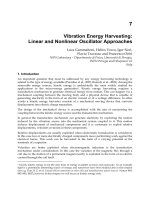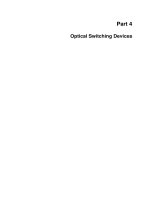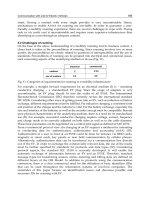Profiles in Cardiac Pacing and Electrophysiology - part 10 docx
Bạn đang xem bản rút gọn của tài liệu. Xem và tải ngay bản đầy đủ của tài liệu tại đây (733.27 KB, 24 trang )
Part 3 Historical Pages 203
Dionysos sits resting on a rock, his leg on the thigh of Ariadne, a pose symbolic
of “sacred marriage.” (Bronze krater from Derveni, 320–300 bc.)
of his father, Jupiter. The wife of Dionysos was Ariadne, the daughter of
Minos. Dr. Nikos Protonotarios and colleagues examined the population
of the Greek island of Naxos and described the so-called Naxos disease
in 1986 (Protonotarios et al., 1986): A syndrome of arrhythmogenic right
ventricular cardiomyopathy (ARVC), non-epidermolytic palmoplantar
keratoderma, and woolly hair. The autosomal recessive ARVC of Naxos
disease is similar to autosomal dominant ARVC with respect to age and
mode of clinical presentation, distribution of right ventricular and left
ventricular involvement, electrocardiographic features, natural history,
and morphological and histological features. Initial clinical presenta-
tion is often with ventricular arrhythmia of left-bundle-branch-block
morphology, which suggests a right ventricular origin. All patients
originally examined by Nikos Protonotarios and his pediatrician wife
Adalena Tsatsopoulou with cardiac abnormalities and familial palmo-
plantar keratosis were descended from families on the Greek island of
Naxos. Cardiomegaly on chest X-ray and electrocardiographic abnorm-
alities were common findings. Three cases had episodes of ventricular
tachycardia and a fourth patient died suddenly. All patients with cardiac
signs and symptoms showed echocardiographic enlargement of the
right ventricle and a right ventricular band; in three the left ventricle was
also affected.
The term “Naxos disease” was introduced by G. Fontaine, N. Pro-
tonotarios, A. Tsatsopoulou and colleagues with an abstract sent to the
204 Part 3 Historical Pages
Normal electrocardiogram (ECG) (a) and two episodes of ventricular
tachycardia (b and c) in patient 1 (single channel recorder). In (a) there was a
QRS axis of > 135 ms, QRS prolongation, low voltage, and T-wave inversion in
the precordial leads. In both (b) and (c) the ventricular tachycardia rate is 160
beats per minute and the QRS axes were > 75 ms and > 135 ms, respectively.
From Protonotarios, N. et al. (1986) (See references)
American Heart Association in 1994 (Fontaine et al., 1994). Based on
electrocardiography and pathology, the authors suggested that Naxos
disease and arrhythmogenic right ventricular dysplasia (ARVD) are
two expressions of the same cardiac disorder. It was supposed that in
Naxos disease ARVD is genetically transmitted and morbidity associated
with palmoplantar keratosis (Fontaine et al., 1994).
Coonar et al. (1998) have confirmed autosomal recessive inheritance
for Naxos disease and mapped the disorder to chromosome 17q21.
Recently, McKoy et al. (2000) have shown a two-base pair homozygous
deletion in the plakoglobin gene in individuals with Naxos disease.
References
Coonar, A.S., Protonotarios, N., Tsatsopoulou, A. et al. (1998) Gene for arrhyth-
mogenic right ventricular cardiomyopathy with diffuse non-epidermolytic
palmoplantar keratoderma and woolly hair (Naxos disease) maps to 17q21.
Circulation, 97, 2049–58.
Fontaine, G., Protonotarios, N., Tsatsopoulou, A. et al. (1994) Comparisons
between Naxos disease and arrhythmogenic right ventricular dysplasia by
electrocardiography and biopsy (Abstract). Circulation, 90(2), 3233.
McKoy, G., Protonotarios, N., Crosby, A. et al. (2000) Identification of a deletion in
plakoglobin in arrhythmogenic right ventricular cardiomyopathy with palmo-
plantar keratoderma and woolly hair (Naxos disease). Lancet, 355, 2119–24.
Protonotarios, N., Tsatsopoulou, A., Patsourakos, P. et al. (1986) Cardiac abnorm-
alities in familial palmoplantar keratosis. British Heart Journal, 56, 321–6.
Bernard Lown (born 1921)*
Bernard Lown was born in Lithuania on June 7, 1921, and immigrated
with his family to the USA in 1935. He studied medicine at the University
of Maine and later at the Johns Hopkins University School of Medicine in
Baltimore, where he earned his doctorate in 1945. After training at vari-
ous hospitals, he held a research position in cardiology at the Peter Bent
Brigham Hospital in Boston from 1950 to 1953. After his military service,
he continued his internship at the Peter Bent Brigham Hospital and
Harvard Medical School in Boston. Lown was then named Director of
the Samuel A. Levine Cardiovascular Research Laboratory from 1956 to
1980, and was on staff at the Peter Bent Brigham Hospital. In addition, he
also served as Assistant Professor of Medicine at the Harvard School of
Public Health from 1961 to 1967. Before he undertook the coordination of
a joint study on sudden cardiac death between the USA and the former
Part 3 Historical Pages 205
* Lüderitz, B. (2004) History. Journal of Interventional Cardiac Electrophysiology, 10,
293–4 (with permission).
USSR from 1973 to 1981, he was Associate Professor of Cardiology at the
Harvard School of Public Health. Bernard Lown is Professor Emeritus of
Cardiology at the Harvard School of Public Health and senior physician
at Brigham and Women’s Hospital in Boston. Cofounder of International
Physicians for the Prevention of Nuclear War (IPPNW), he accepted the
Nobel Peace Prize on behalf of the organization in 1985.
206 Part 3 Historical Pages
Bernard Lown (right) and Ewgeni Chazow (Minister of Health of the former
USSR) receiving the Nobel Peace Prize in 1985.
Cardioversion in a patient with ventricular tachycardia (VT). After the
defibrillatory discharge of 100 watts, there was an asystolic pause of 2.08 seconds
followed by normal sinus rhythm (NSR).
He developed the DC defibrillator and the cardioverter, and intro-
duced lidocaine as an antiarrhythmic drug. Lown and electrical engineer
Dr. Bernard Berkowitz studied the efficacy and safety of several DC
waveforms in animals, showing that one was consistently effective in
reversing the most intractable episodes of ventricular fibrillation that did
not respond to alternating current. They learned that ventricular fibrilla-
tion could be prevented by synchronizing the shock to avoid the vulner-
able period of the cardiac cycle, thereby providing a safe method for
reverting tachycardias, a method that Lown called “cardioversion.” This
is also true for atrial fibrillation. His recent work demonstrates the role of
psychological and behavioral factors in regulating the heart.
Dr. Lown is the recipient of the George F. Kennan Award, as well
as numerous honorary degrees and other awards both in the USA and
abroad. In 1998, he received the Pioneer in Cardiac Pacing and Elec-
trophysiology Award of the North American Society of Pacing and
Electrophysiologyatoday the Heart Rhythm Society.
References
Lown, B., Amarasingham, R. & Neumann, J. (1962) New method for terminating
cardiac arrhythmias. Use of synchronized capacitor discharge. JAMA: The Jour-
nal of the American Medical Association, 182, 548–55.
Part 3 Historical Pages 207
Lown, B., Perlroth, M.G., Kaidbey, S., Abe, T. & Harken, D.E. (1963) “Cardiover-
sion” of atrial fibrillation. A report on the treatment of 65 episodes in 50
patients. New England Journal of Medicine, 269, 325–31.
Lüderitz, B. (2002) History of the Disorders of Cardiac Rhythm, 3rd edn. Futura,
Armonk, NY.
Alan John Camm (born 1947)*
A. John Camm is an Englishman born in Lincolnshire in the north of
England. At the 18 years of age he entered the University of London,
where he obtained his baccalaureate degree with a physiology major. He
went on to study medicine at Guy’s Hospital Medical School, receiving
his MD in 1971. Afterwards, he worked at Guy’s Hospital for 3 years
under the tutelage of cardiologist Edgar Sowton, one of the greats of the
early days of pacing. Dr. Camm’s doctoral thesis was entitled “The appli-
cation of pacemakers to tachycardia termination,” which was accepted
by the University of London in 1981.
Professor Camm is a past Chairman of the European Working Group
on Arrhythmias, a past President of the British Pacing and Electrophy-
siology Group, and currently the President of the British Cardiac Society.
He is widely recognized for his research and teaching roles at national
and international levels. In 2001, the North American Society of Pacing
and Electrophysiology awarded him the Distinguished Teacher Award.
208 Part 3 Historical Pages
Date of Birth: 11 January, 1947, Lincolnshire
Country of Birth: England, United Kingdom
Nationality: very British
Marital Status: married – Joy-Maria
(nee Frappell)
Children: Christian John Fielder,
Kathryn Lucy Ellis
Queen’s Honorary Physician (QHP)
Bachelor of Science (BSc)
Medical Doctor (MD)
Fellow of the Royal College of Physicians (FRCP)
Fellow of the American College of Cardiology (FACC)
Founding Fellow of the European Society of Cardiology
(FESC)
Fellow of the Council of Geriatric Cardiology (FCGC)
Commander of the Venerable Order of St. John of
Jerusalem (CSt.J)
Professor of Clinical Cardiology (British Heart
Foundation), The Prudential Chair of Cardiology,
St. George’s Hospital Medical School, University of
London
Honorary Consultant in Cardiology, St. George’s
Hospital
Alan John Camm
Camm, together with Dr. S. Saksena, is coediting a major textbook
entitled Electrophysiological Disorders of the Heart (not yet published).
Reference
Lüderitz, B. (2003) Alan John Camm. In: Profiles in cardiology (eds J.W. Hurst &
W.B. Fye). Clinical Cardiology, 26, 251–3.
Heinz Sterz; Transesophageal pacing*
Transesophageal procedures for electrophysiological stimulation were
firstly published by the Second Department of Medicine of the
Landeskrankenhaus KlagenfurtaAustria (Sterz et al., 1978). The pub-
lication by Sterz et al. (1978) is the first report describing the successful
termination of paroxysmal supraventricular tachycardia in nine patients
by rapidly stimulating the left atrium by an esophageal stimulation
probe adjacent to the left atrium. This report is also mentioned by
Gallagher et al. (1982) as the first description of the method.
210 Part 3 Historical Pages
* Lüderitz, B. (1998) History. Journal of Interventional Cardiac Electrophysiology, 2,
309 (with permission).
Transesophageal rapid stimulation of the left atrium in atrial tachycardias.
Electrocardiograms (ECGs) of a patient before, during, and after
transesophageal rapid stimulation of the left atrium (oeRLAS) via an esophageal
stimulation catheter. (Left) Leads I, II, III, aVR, aVL, and aVF, and two esophageal
leads: atrial tachycardia with 2 : 1 atrioventricular (AV) block. (Center and right
[in a continuous recording]) Rapid left atrial stimulation via the esophageal
catheter; artificial induction of atrial fibrillation. After stopping of esophageal
rapid left atrial stimulation (oeRLAS): sinus rhythm after the second beat.
References
Gallagher, J.J., Smith, W.M., Kerr, C.R. et al. (1982) Esophageal pacing: A diag-
nostic and therapeutic tool. Circulation, 65, 336–41.
Sterz, H., Prager, H. & Koller, H. (1978) Transösophageale rasche Stimu-
lation des linken Vorhofes zur Elektrotherapie ektoper, tachykarder Vorho-
frhythmusstörungen. Zeitschrift fur Kardiologie, 87, 135–8.
Sterz, H., Prager, H. & Koller, H. (1981) Transösophageale Prüfung der
Sinusknotenfunktion. Herzschrittmacher, 1, 45–7.
Obituary: Philippe Coumel (1935–2004): A giant of modern
clinical electrophysiology* by Samuel Lévy
On March 18, 2004, our colleague and friend Professor Philippe Coumel
of Hôpital Lariboisière of Paris, died at age 68 after a terrible disease
which had handicapped him for the last few years. French cardiology is
deeply saddened as well as the field of cardiac electrophysiology world-
wide. His European colleagues and colleagues from all over the world
have manifested their sympathy as Philippe was one of the most appreci-
ated and respected opinion leaders in our field. Our first thoughts and
condolences are directed towards his family, his wife Claude and his
three children, who represent what he cherished most. Aside from his
family, Philippe Coumel’s life was entirely devoted to cardiology, par-
ticularly to the understanding of cardiac arrhythmias. When his interest
for this field started in the mid 1960s, as a pupil of Professor Bouvrain,
we didn’t have any significant insights into arrhythmia mechanisms,
Part 3 Historical Pages 211
* Lüderitz, B. (2004) History. Journal of Interventional Cardiac Electrophysiology, 11,
77–8 (with permission).
aside from the speculative interpretation of electrocardigrams (ECGs)
using ladder diagrams and deductive reasoning. Coumel teamed with
Prof. Robert Slama and they have worked together since then, advancing
month after month as if explorers of a new continent. They represented a
source of admiration for fellows in cardiology all over France, and
inspired interest for arrhythmology in the new generation.
While I was a fellow at the University of Miami, my mentor Dr.
Agustin Castellanos, familiar with Philippe Coumel’s work, most of it
written in French at that time, advised me to meet with him during a trip
to Paris and to invite him back as a guest of the University of Miami,
which I did. A few months later Philippe visited us in Miami and I was
very proud to introduce him to Drs. Onkar Narula, Robert Myerburg,
and Agustin Castellanos. Back in France, I visited with him regularly at
Hôpital Lariboisière, where he was conducting active research using
programmed electrical stimulation in patients with supraventricular
tachycardias at a time when the focus was mainly on conduction disturb-
ances using His bundle recordings.
Philippe Coumel’s contribution to our field is enormous. He was
among the first, along with Prof. H.J.J. Wellens, to use programmed
electrical stimulation in order to understand the mechanism of par-
oxysmal supraventricular tachycardias involving the atrioventricular
(AV) node, and to describe the reciprocating mechanism of atrioventricu-
lar nodal reentrant tachycardias (AVNRT). He described the perman-
ent junctional reciprocating tachycardias (PJRT, referred to in France as
tachycardies de Coumel), whose mechanism involving a slow conducting
concealed accessory connection was subsequently demonstrated by John
Gallagher, another major contributor to our field. Philippe Coumel also
described catecholamine-induced polymorphic ventricular tachycardias
in children. His interest in the autonomous nervous system and its
analysis using ambulatory 24-hour recording and computer analysis
resulted in the definition of other new syndromes such as vagal atrial
fibrillationaoccurring at night, during sleep, or after heavy mealsa or
torsades de pointesainduced by short coupled ventricular extrasystoles
in patients with normal QT interval. His contribution to our field is
remarkable in many ways, and it is not my purpose to describe in detail
what all arrhythmologists are familiar with.
Philippe Coumel is simply irreplaceable. He had an exceptional sense
of observation and an intuitive reasoning, which elicited the admiration
of all those who had the chance to work with him or to approach him.
Until the end, he continued to practice medicine and to visit his patients
whom he was eager to help. Philippe Coumel was a man of character, a
man of wisdom, and a man of strong convictions, although he was
always ready to listen to different opinions. Another aspect of Philippe
212 Part 3 Historical Pages
Coumel’s personality is that he had a hidden sensitiveness, which made
him a warm human being to those capable of discovering this aspect and
a faithful friend. I had the good fortune to be one of his friends and was
privileged with Prof. Fauchier to have shared with him and Claude, his
wife, a dinner at the EUROPACE meeting in Paris last December, which
he accepted despite the handicap of his illness. He will be remembered
by all arrhythmologists as a giant and a pioneer of modern electrophysi-
ology. His friends will miss him and he will remain dear to our hearts.
The best tribute to Philippe comes from my daughter Virginie, aged
24, who asked me why I felt sad. I told her that a friend of mine, Philippe
Coumel, had passed away and she said, “It is sad since his name has been
with me throughout my childhood.”
Samuel Lévy, MD, FACC, FESC, University of Marseille, France
Douglas Peter Zipes (born 1939)*
Douglas Peter Zipes was born in White Plains, New York, on February
27, 1939, and grew up in Pleasantville, New York. After attending
Dartmouth Medical School in Hanover, New Hampshire, he transferred
to Harvard Medical School, where he graduated 1964 cum laude. His
Part 3 Historical Pages 213
* Lüderitz, B. (2004) History. Journal of Interventional Cardiac Electrophysiology, 10,
1–2 (with permission).
internship and residency in internal medicine and his fellowship in
cardiology were at Duke University Medical Center, Durham, North
Carolina. After his military service (Navy) he joined the cardiovascular
faculty of Indiana, University School of Medicine, Indianapolis, Indiana,
where he has been ever since. Within 6 years he became a full professor.
In 1994, he achieved the rank of Distinguished Professor, and in 1995 he
became Director of the Cardiology Division and the Krannert Institute of
Cardiology.
Dr. Zipes is a premier electrophysiologist, researcher, teacher, author,
and the only Editor of The Journal of Cardiovascular Electrophysiology until
2004. Since May 2004, he has been the Editor of Heart Rhythm, the official
Journal of the North American Society of Pacing and Electrophysiology
(NASPE)–Heart Rhythm Society. For various periods, he was Editor and
Chief of Progress in Cardiology, Contemporary Treatments in Cardiovascular
Disease, and Cardiology in Review. He holds five patents, including the
synchronous intracardiac cardioverter. He introduced the concept of
214 Part 3 Historical Pages
The American Journal of CARDIOLOGY 1971; 28:211 -222
The Contribution of Artificial Pacemaking to
Understanding the Pathogenesis of Arrhythmias
DOUGLAS P. ZIPES, MD*
Portsmouth, Virginia
From the Cardiopulmonary
Laboratory, Department of
Medicine, Naval Hospital,
Portsmouth, Va.
Right atrial or ventricular pacing was
performed on 36 occasions in 26 patients
in an attemptto terminatea variety of
tachyarrhythmias. Of 16 episodes of
atrial flutter, 13 were terminated suc-
cessfully; in 9 of the 13, sinus rhythm
or the patient‘s pre-flutter rhythm was
restored immediately, whereas in 4
patients, intervening atrial fibrillation
or unstable atrial flutter occured. Pacing
terminated paroxysmae atrioventricular
junctional or paroxysmal atrial tachy-
cardia on 3 occasions; in a fourth patient,
this tachyarrhythmia terminated during
catheter manipulation. Six episodes of
pacemaker-induced ventricular tachy-
cardia were abolished by ventricular
pacing. In 2 patients, atrial tachycardia
was only transiently suppressed, and
in 1 of these patients, d-c cardioversion
produced a similar effect. Atrial fibrilla-
tion, spontaneously converting to atrial
flutter, resulted during pacing for atrial
tachycardia with block, the latter arrhy-
thmia returned when the atrial flutter
was terminated.
low-power defibrillation for ventricular arrhythmias, and has been
noted for his leadership of multicenter, prospective randomized clinical
trials such as the AVID (antiarrhythmic versus implantable defibrillator)
trial. He was Chair of the American Board of Internal Medicine Com-
mittee, which developed the examination in clinical cardiac electrophy-
siology, and has been President of the North American Society of Pacing
and Electrophysiology. Zipes became President of the American College
of Cardiology in March 2001 (Orlando, Florida). Furthermore, as an avid
opera supporter for decades, he served as President of the Indianapolis
Opera’s Board of Directors.
Dr. Zipes published approximately 290 articles in peer-reviewed med-
ical journals, 14 books, and more than 400 review articles or chapters in
books or editorials. His comprehensive text book Cardiac Electrophy-
siology: From Cell to Bedside (Coeditor: José Jalife, MD W.B. Saunders,
Philadelphia, 2004) appeared recently in its fourth edition.
Douglas P. Zipes has been married to Joan Jacobus for 42 years; he has
three children and five grandchildren. As a hobby he (and his wife) are
ambitiously writing detective novels.
References
Roberts, W.C. (2003) Douglas Peter Zipes, MD: A conversation with the Editor.
The American Journal of Cardiology, 91, 831–56.
Lüderitz, B. (2002) History of the Disorders of Cardiac Rhythm, 3rd edn. Futura,
Armonk, NY.
Miller, J.M. (2004) Douglas P. Zipes. Clinical Cardiology, 27, 179–80.
Part 3 Historical Pages 215
Douglas P. Zipes (middle) on a private tour to Lhasa, Tibet, in front of the
Outpatient Clinic, Traditional Tibetian Medicine, Hospital of the Tibet
Autonomous Region. His colleagues (from right to left): Warren Jackman, Ralph
Lazarra, Douglas P. Zipes, Edward Platia, Berndt Lüderitz.
216 Part 3 Historical Pages
1) K.H. Kuck, 2) G. Steinbeck, 3) Mrs. Kuck, 4) S. Hohnloser, 5) G. Ayers,
6) J. Brachmann, 7) W. Schoels, 8) Mrs. Akhtar, 9) Mrs. Allessie, 10) L. Jordaens,
11) K. Wheeler, 12) J. Griffin, 13) M. Allessie, 14) M. Akhtar, 15) H. Lüderitz,
16) H.J. Biersack, 17) M. Lesh, 18) A. Waldo, 19) K. Steinbach, 20) T. Schumacher,
21) K. Lenz, 22) B. Schumacher, 23) M. Manz, 24) W. Jung, 25) Mrs. Furlanello,
26) K. Seidl, 27) H. Omran, 28) Mrs. Klein, 29) M. Santini, 30) A.J. Camm,
31) Mrs. Manz, 32) F. Furlanello, 33) H. Klein, 34) M. Lussier, 35) H.J. Trappe,
36) D. Andresen, 37) B. Lüderitz, 38) H. Schilling, 39) S. Lüderitz, 40) S. Lévy,
41) S. Saksena, 42) A. Cappucci, 43) J. Jalife, 44) H.F. Pitschner, 45) G. Breithardt,
46) A. Kirkutis
Appendix 1
History Table
1580 Mercuriale, G. (1530–1606): Ubi pulsus sit rarus semper
expectanda est syncope
1717 Gerbezius, M. (1658–1718): Constitutio Anni 1717 a.A.D.
Marco Gerbezio Labaco 10. Decem. descripta. Miscellanea-
Emphemerides Academiae Naturae Curiosorum. Cent. VII, VIII.
1718: in Appendice
1761 Morgagni, G.B. (1682–1771): De sedibus et causis morborum
per anatomen indagatis
1791 Galvani, L. (1737–1798): De viribus electricitatis in motu
musculari commentarius
1800 Bichat, M.F.X. (1771–1802): Recherches physiologiques sur la
vie et la mort
1804 Aldini, G. (1762–1834): Essai theorique et experimental sur le
galvanisme, avec une serie d’experiences faites en presence des
commissaires de L’Institut National de France, et en divers
amphitheatres de Londres
1827/1846 Adams, R. (1791–1875); Stokes, W. (1804–1878): Cases of
diseases of the heart, accompanied with pathological observations:
observations on some cases of permanently slow pulse
1872 Duchenne de Boulogne, G.B.A. (1806–1875): De I’electrisa-
tion localisee et de son application à la pathologie et à la
therapeutique par courants induits et par courants galviniques
interrompus et continues
1882 von Ziemssen, H. (1829–1902): Studies on the motions of the
human heart as well as the mechanical and electrical excitability
of the heart and phrenic nerve, observed in the case of the exposed
heart of Catharina Serafin
1890 Huchard, H.: La Maladie de Adams–Stokes
217
1932 Hyman, A.S.: Resuscitation of the stopped heart by intracardial
therapy. II. Experimental use of an artificial pacemaker
1952 Zoll, P.M.: Resuscitation of heart in ventricular standstill by
external electrical stimulation
1958 Elmquist, R.; Senning, Å.: An implantable pacemaker for the
heart
1958 Furman, S.; Robensin, G.: The use of an intracardiac pacemaker
in the correction of total heart block
1961 Bouvrain, Y.; Zacouto, F.: L’Entrainement électrosystolique du
coeur
1962 Lown, B. et al.: New method for terminating cardiac
arrhythmias
1963 Nathan, D.A. et al.: An implantable synchronous pacemaker for
the long-term correction of complete heart block
1969 Berkovits, B.V. et al.: Bifocal demand pacing
1969 Scherlag, B.J. et al.: Catheter technique for recording His bundle
activity in man
1972 Wellens, H.J.J. et al.: Electrical stimulation of the heart in
patients with ventricular tachycardia
1975 Zipes, D.P. et al.: Termination of ventricular fibrillation in dogs
by depolarizing a critical amount of myocardium
1978 Josephson, M.E. et al.: Recurrent sustained ventricular
tachycardia
1978 Funke, H.D.: First dual-chamber pacemaker
1980 Mirowski, M. et al.: Termination of malignant ventricular
arrhythmias with an implanted automatic defibrillation in
human beings
1981 Breithardt, G. et al.: Non-invasive detection of late potentials in
manaa new marker for VT
1982 Gallagher, J.J. et al.: Catheter technique for closed-chest ablation
of the atrioventricular conduction system: A therapeutic
alternative for the treatment of refractory supraventricular
tachycardia
218 Appendix 1 History Table
1982 Scheinman, M.M. et al.: Transvenous catheter technique for
induction of damage to the atrioventricular junction in man
1986 Lüderitz, B.; Gerckens, U.; Manz, M.: Antitachycardia
pacemaker (Tachylog) and automatic implantable defibrillator
(AID): combined use in ventricular tachyarrhythmias
1987 Borggrefe, M. et al.: High frequency alternating current
ablation of an accessory pathway in humans
1988 Saksena, S.; Parsonnet, V.: Implantation of a cardioverter-
defibrillator without thoracotomy using a triple electrode system
1991 Jackman, W.M. et al.: Catheter ablation of accessory
atrioventricular pathways (Wolff–Parkinson–White syndrome)
by radiofrequency current
1991 Kuck, K.H. et al.: Radiofrequency current catheter ablation of
accessory atrioventricular pathways
1994 Daubert, C. et al.: Permanent atrial resynchronisation by
synchronous biatrial pacing in the preventive treatment of atrial
flutter associated with high degree interatrial block
1994 Cazeau, S.; Mugica, J. et al.: Four chamber pacing in dilated
cardiomyopathy
1995 Camm, A.J. et al.: Implantable atrial defibrillator
1996 Saksena, S. et al.: Dual-site right atrial pacing for atrial
fibrillation
1997 Jung, W.; Lüderitz, B.: Implantation of an arrhythmia
management system for ventricular and supraventricular
tachyarrhythmias
1998 Haïssaguerre, M. et al.: Spontaneous initiation of atrial
fibrillation by ectopic beats originating in the pulmonary veins
1998 Huang, D.T. et al.: Hybrid pharmacologic and ablative therapy:
A novel and effective approach for the management of atrial
fibrillation
Appendix 1 History Table 219
Appendix 2
NASPE (North American Society of
Pacing and Electrophysiology)–Heart
Rhythm Society
Past Presidents
Michael E. Cain, MD, 2003–2004
Mark H. Schoenfeld, MD, 2002–2003
Eric N. Prystowsky, MD, 2001–2002
David S. Cannom, MD, 2000–2001
Gerald V. Naccarelli, MD, 1999–2000
David L. Hayes, MD, 1998–1999
Sanjeev Saksena, MD, 1997–1998
John D. Fisher, MD, 1996–1997
Ralph Lazzara, MD, 1995–1996
Nora Goldschlager, MD, 1994–1995
David G. Benditt, MD, 1993–1994
Gerald C. Timmis, MD, 1992–1993
James D. Maloney, MD, 1991–1992
Victor Parsonnet, MD, 1990–1991
Douglas P. Zipes, MD, 1989–1990
Melvin M. Scheinman, MD, 1988–1989
Doris J.W. Escher, MD, 1988
Michael Bilitch, MD, 1987
Paul C. Gillette, MD, 1986–1987
Jerry C. Griffin, MD, 1985–1986
Albert L. Waldo, MD, 1984–1985
Robert G. Hauser, MD, 1983–1984
Bernard Goldman, MD, 1982–1983
Seymour Furman, MD, 1981–1982
J. Warren Harthorne, MD, 1979–1981
Distinguished Scientist Award recipients
Michael R. Rosen, MD, 2004
Andrew L. Wit, PhD, 2003
Charles Antzelevitch, PhD, 2002
Peter J. Schwartz, MD, 2001
220
Robert J. Myerburg, MD, 2000
Ralph Lazzara, MD, 1999
Maurits A. Allessie, MD, PhD, 1998
J. Thomas Bigger Jr., MD, 1998
Madison S. Spach, MD, 1997
Albert L. Waldo, MD, 1997
James L. Cox, MD, 1996
Gerard M. Guiraudon, MD, 1996
Douglas P. Zipes, MD, 1995
Paul F. Cranefield, MD, PhD, 1994
Michiel J. Janse, MD, 1993
Borys Surawicz, MD, 1992
Mauricio B. Rosenbaum, MD, 1991
Agustin Castellanos, MD, 1990
Maurice Lev, MD, 1989
Godon K. Moe, MD, PhD, 1988
Michel Mirowski, MD, 1987
Will C. Sealy, MD, 1987
Charles Kossmann, MD, 1986
John C. Callaghan, MD, 1985
Wilfred G. Bigelow, MD, 1985
Jack Hopps, 1985
Wilson Greatbatch, PE, 1984
Brian F. Hoffman, MD, 1983
Barouh Berkovits, MSEE, 1982
Distinguished Service Award recipients
Nancy L. Stephenson, BSN, 2004
Barbara K. Krause, MA, 2003
Melanie T. Gura, MSN, CSN, 2002
Daniel E. Nickelson, 2001
Wilton W. Webster, BSME, 2000
Leonard A. Cobb, MD, 1999
Carol J. McGlinchey, 1998
Jennifer A. Fraser, RN, 1996
Jacques Mugica, MD, 1995
Susan L. Song, RN, BSN, 1994
J. Warren Harthorne, MD, 1992
Henry D. McIntosh, MD, 1991
Victor Parsonnet, MD, 1990
Seymour Furman, MD, 1989
J. Walter Keller, BSEE, MS, 1988
Appendix 2 NASPE–Heart Rhythm Society 221
Jean-J. Welti, MD, 1986
Earl Bakken, 1985
William P. Murphy, MD, 1985
David Link, 1980
Distinguished Teacher Award recipients
Fred Morardy, MD, 2004
George J. Klein, MD, 2003
Eric N. Prystowsky, MD, 2002
A. John Camm, MD, 2001
Hein J.J. Wellens, MD, 2000
John J. Gallagher, MD, 1999
Nora Goldschlager, MD, 1998
Howard B. Burchell, MD, 1997
Mark E. Josephson, MD, 1996
Leonard S. Dreifus, MD, 1995
Charles Fisch, MD, 1994
S. Serge Barold, MD, 1992
Pioneer in Cardiac Pacing and Electrophysiology recipients
Michel Haïssaguerre, MD, 2004
John D. Fisher, MD, 2003
Jeremy N. Ruskin, MD, 2002
Mark E. Josephson, MD, 2001
Warren Jackman, MD, 2000
Kenneth B. Stokes, B Ch, 2000
Masood Akhtar, MD, 1999
Victor Parsonnet, MD, 1999
Paul C. Gillette, MD, 1998
Bernard Lown, MD, 1998
Philippe Coumel, MD, 1997
Melvin M. Scheinman, MD, 1996
Hein J.J. Wellens, MD, 1995
Herman K. Hellerstein, MD, 1993
Anthony N. Damato, MD, 1992
Nicholas P.D. Smyth, MD, 1992
Leonardo Cammilli, MD, 1991
William W.L. Glenn, MD, 1990
Doris J.W. Escher, MD, 1989
Benjamin J. Scherlag, PhD, 1989
Paul M. Zoll, MD, 1989
222 Appendix 2 NASPE–Heart Rhythm Society
President’s Award recipients
Peter M. Spooner, PhD, 2004
David S. Cannom, MD, 2002
Morton M. Mower, MD, 2000
Glenn Rahmoeller, MS, 1986
Doris J.W. Escher, MD, 1985
J. Warren Harthorne, MD, 1984
Heart Rhythm Society Distinguished Achievement
Award recipients
Arthur J. Moss, MD, 2000
Seymour Furman, MD, 1996
Appendix 2 NASPE–Heart Rhythm Society 223
Adams, Robert, 3
Akhtar, Masood, 3
Aliot, Etienne, 4
Allessie, Maurits A., 5
Anderson, Jeffrey L., 6
Andresen, Dietrich, 6
Antzelevitch, Charles, 6
Aristotle, 7
Asclepius, 7
Auricchio, Angelo, 8
Avicenna, 8
Bakken, Earl E., 9
Barold, S. Serge, 9
Bayés de Luna, Antonio, 10
Benditt, David Guay, 10
Berkovits, Barouh, 11
Bigger, J. Thomas, Jr., 11
Blanc, Jean-Jacques, 11
Bloch Thomsen, Poul Erik, 11
Blomström-Lundqvist, Carina, 12
Boerhaave, Herman, 12
Borbola, Joseph, 12
Borggrefe, Martin, 13
Bouvrain, Yves, 13
Brachmann, Johannes, 14
Bredikis, Jurgis, 14
Breithardt, Günter, 14
Brignole, Michele, 15
Brugada, Josep, 15
Brugada, Pedro, 15
Brugada, Ramon, 16
Cain, Michael E., 17
Calkins, Hugh G., 17
Camm, A. John, 18, 208
Appendix 3
Name Index
224
Cammilli, Leonardo, 19
Campbell, Ronald W.F., 19
Cannom, David S., 20
Cappato, Riccardo, 20
Capucci, Alessandro, 21
Castellanos, Agustin, 21, 194
Chardack, William, 22
Chen, Shih-Ann, 22
Clémenty, Jacques, 22
Cobbe, Stuart Malcom, 22
Connolly, Stuart J., 23
Cosio, Francisco G., 23
Coumel, Philippe, 23, 188, 211
Cox, James L., 24
Cranefield, Paul F., 24
Crijns, Harry, 24
Curtis, Anne B., 24
Damato, Anthony N., 25
Daubert, Jean Claude, 25
Della Bella, Paolo, 25
Descartes, René, 26
Dessertenne, François, 27
Dodinot, Bernard, 27
Doppler, Christian, 27
Dorian, Paul, 28
Dreifus, Leonard S., 28
Durrer, Dirk, 28, 164
Ector, Hugo, 29
Effert, Sven, 29
Einthoven, Willem, 29, 149
Elmqvist, Rune, 30
El-Sherif, Nabil, 31
Engelmann, Theodor Wilhelm, 31
Epstein, Andrew E., 31
Appendix 3 Name Index 225
Escher, Doris J.W., 32
Estes, Mark N.A., III, 32
Falk, Rodney, 33
Faraday, Michael, 33
Farré, Jerónimo, 33
Fisch, Charles, 33
Fisher, John D., 34
Fleckenstein, Albrecht, 34
Fontaine, Guy, 35
Forssmann, Werner, 35
Frank, Robert, 36
Franz, Michael R., 36
Fuchs, Leonhart, 37
Funke, Hermann, 37
Furlanello, Francesco, 38
Furman, Seymour, 38, 184
Fye, W. Bruce, 39
Gaita, Fiorenzo, 39
Galen, 39
Gallagher, John J., 40
Galvani, Luigi, 40
Gerbezius, Marcus, 41, 137
Gillette, Paul, 42
Goldschlager, Nora, 42
Greatbatch, Wilson, 42
Griffin, Jerry C., 43
Groedel, Franz Maximilian, 43,
162
Grüntzig, Andreas R., 190
Guiraudon, Gerard M., 44
Guize, Louis J., 44
Gulizia, Michele M., 44
Haines, David E., 45
Haïssaguerre, Michel, 45
Hammill, Stephen C., 46
Harken, Dwight, 46
Harthorne, J. Warren, 46
Harvey, William, 46
Hatala, Robert, 47
Hauer, Richard N.W., 48
Hauser, Robert G., 48
Hayes, David L., 48
Herophilus, 49
Hippocrates, 49, 135
His, Wilhelm, Jr., 50
Hoffman, Brian, 50
Hoffmann, Ellen, 50
Hohnloser, Stefan, 50
Hollman, Arthur, 51
Holzmann, Max, 51
Hori, Motokazu, 51
Ideker, Raymond E., 51
Irnich, Werner, 52
Iwa, Takashi, 52
Jackman, Warren M., 52
Jaïs, Pierre, 52
Jalife, José, 53
Janse, Michiel J., 53
Jordaens, Luc J.L.M., 54
Josephson, Mark E., 54
Kappenberger, Lukas, 55
Kautzner, Josef, 55
Kenda, Miran F., 56
Kisch, Bruno, 56
Kléber, André G., 56
Klein, George J., 57
Klein, Helmut, 58
Kowey, Peter R., 58
Krikler, Dennis M., 58
Kuck, Karl-Heinz, 59
Laënnec, Théophile Réné
Hyacinthe, 59
Lagergren, Hans, 60
La Rovere, Maria Teresa, 60
Larsson, Arne, 60
Lau, Chu Pak, 61
Lazzara, Ralph, 62
Le Heuzey, Jean-Yves, 62
Lesh, Michael, 63
Lévy, Samuel, 63
Lewalter, Thorsten, 64
Lewis, Thomas, 64
Lillehei, C. Walton, 65
Linde, Cecilia, 65
Lindsay, Bruce D., 66
Lombardi, Federico, 66
Lown, Bernard, 67, 205
Luceri, Richard M., 67
Lüderitz, Berndt, 68
Ludwig, Carl Friedrich Wilhem,
142
Mahaim, Ivan, 68, 168
Malik, Marek, 69
Manolis, Antonis S., 70
Marchlinski, Francis E., 70
Marcus, Frank I., 71
Marey, Etienne Jules, 71, 144
Mason, Jay W., 72
McWilliam, John A., 186
Meinertz, Thomas, 72
Mirowski, Mieczyslaw (Michel),
72
Mitsui, Toshio, 73
Mobitz, Woldemar, 73, 133
Moe, Gordon K., 74
Mond, Harry George, 75
Morady, Fred, 75
Morgagni, Giovanni Battista, 76
Moss, Arthur, 77
Mower, Morton, 77
Mugica, Jacques E., 78, 180
Murgatroyd, Francis D., 78
Myerburg, Robert J., 78
Naccarelli, Gerald V., 79
Natale, Andrea, 80
Nattel, Stanley, 80
Olsson, Bertil S., 81
Oseroff, Oscar, 81
Oto, Ali, 81
Ovsyshcher, I. Eli, 82
Pacifico, Antonio, 82
Packer, Douglas L., 83
Pappone, Carlo, 83
Paracelsus, 139
Parkinson, John, 159
Parsonnet, Victor, 84
Pasteur, Louis, 84
Petrac, Dubravko, 85
Pick, Alfred, 85
226 Appendix 3 Name Index
Porstmann, W., 86
Pratt, Craig M., 86
Priori, Silvia G., 86
Pritchett, Edward L.C., 86
Prystowsky, Eric N., 87
Puech, Paul, 87
Purkinje, Jan Evangelista, 140
Raviele, Antonio, 88
Reiffel, James A., 88
Rickards, Anthony, 88
Ritter, Philippe, 89
Rizzon, Paolo, 89
Romano, Cesarino, 176
Rosen, Michael R., 89
Rosenbaum, Mauricio B., 90, 192
Ruskin, Jeremy N., 90
Ryden, Lars, 90
Saksena, Sanjeev, 91
Samet, Philip, 91
Santini, Massimo, 92
Saoudi, Nadir, 93
Schaldach, Max G.J., 93, 178
Scheinman, Melvin M., 93
Scherlag, Benjamin, 95
Schoenfeld, Mark H., 95
Scholz, Hasso, 95
Schwartz, Peter J., 95
Seipel, Ludger, 96
Sénac, Jean-Baptiste de, 96
Senning, Åke, 97
Sethi, Kamal K., 97
Singer, Igor, 97
Singh, Bramah N., 98
Slama, Robert C., 98
Sloman, J. Graeme, 98
Smeets, Joseph L.R.M., 98
Sodi-Pallares, Demetrio, 196
Sowton, Edgar, 99
Surawicz, Borys, 99
Sutton, Richard, 100
Steinbach, Konrad K., 101
Steinbeck, Gerhard, 101
Stokes, William, 101









